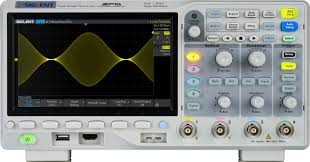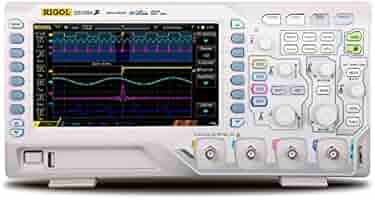Economical Oscilloscopes: A Comparison of Key Features and Capabilities
Oscilloscopes are vital tools for visualizing and analyzing electrical signals in electronic circuit development and troubleshooting. For hobbyists, makers, and even small labs, there are several economical options on the market that offer advanced features while remaining budget-friendly. In this article, we explore several popular models, including the Siglent SDS1104X-E and Rigol DS1054Z, focusing on their performance, usability, and value for money.
1. Siglent SDS1104X-E Digital Oscilloscope
 The Siglent SDS1104X-E is a four-channel oscilloscope with a 100 MHz bandwidth and a sample rate of 1 GSa/s (gigasamples per second). It offers an exceptional combination of features for its price, making it a popular choice among both enthusiasts and professionals.
The Siglent SDS1104X-E is a four-channel oscilloscope with a 100 MHz bandwidth and a sample rate of 1 GSa/s (gigasamples per second). It offers an exceptional combination of features for its price, making it a popular choice among both enthusiasts and professionals.
-
Bandwidth and Sample Rate: With a bandwidth of 100 MHz, this oscilloscope is suitable for observing high-speed digital signals and analyzing analog circuits at frequencies up to 100 MHz. The 1 GSa/s sample rate ensures that you get a detailed representation of the waveform, which is crucial for accurately capturing fast transitions and details in the signal.
-
Trigger Modes: The SDS1104X-E provides multiple trigger modes, including edge, pulse, video, slope, and more. These trigger options help you isolate specific events in the signal, making troubleshooting easier.
-
Webserver Capability: One standout feature of the Siglent SDS1104X-E is its Ethernet port, which enables you to connect it to a local network. The built-in webserver allows you to access and control the oscilloscope from a browser on your local network, making it convenient for remote monitoring and adjustments.
-
Channel Voltage Limits: The input voltage range for each channel is up to 300V peak, which is sufficient for most low- to mid-voltage projects. Safety features include overvoltage protection to prevent damage to the oscilloscope.
2. Rigol DS1054Z Digital Oscilloscope
 The Rigol DS1054Z is another four-channel oscilloscope that is well-regarded for its performance and price point. It has a 50 MHz bandwidth, which can be upgraded to 100 MHz via software, and a sample rate of 1 GSa/s.
The Rigol DS1054Z is another four-channel oscilloscope that is well-regarded for its performance and price point. It has a 50 MHz bandwidth, which can be upgraded to 100 MHz via software, and a sample rate of 1 GSa/s.
-
Bandwidth and Sample Rate: The default 50 MHz bandwidth is sufficient for many low- and mid-frequency applications, and the 1 GSa/s sample rate ensures that signals are captured accurately. For users needing more bandwidth, Rigol offers an upgrade that unlocks up to 100 MHz, providing added flexibility.
-
Trigger Modes: The DS1054Z includes various trigger options such as edge, pulse, and video. The advanced trigger modes allow for better isolation of specific signal characteristics, making it easier to diagnose issues.
-
Network Connectivity: Although the DS1054Z lacks a built-in webserver, it does have USB and LAN connectivity, allowing you to connect the oscilloscope to a computer for remote control and data acquisition using Rigol's software.
-
Channel Voltage Limits: The channel voltage range is similar to the Siglent at 300V peak, ensuring safe operation for most electronic projects. Overvoltage protection is also included to protect the oscilloscope from accidental high-voltage spikes.
3. Owon VDS1022I PC-Based Oscilloscope
The Owon VDS1022I is a more economical option that provides a 25 MHz bandwidth and connects directly to your PC, making it a convenient and cost-effective choice for users who already use a computer as their main workstation.
-
Bandwidth and Sample Rate: The 25 MHz bandwidth is suitable for low-frequency analog and digital signals, while the 100 MSa/s (megasamples per second) sample rate is sufficient for capturing basic waveforms and signals in most DIY projects.
-
Trigger Modes: The Owon VDS1022I offers basic trigger modes, including edge and pulse, allowing users to capture signals at specific intervals or events. Although not as advanced as higher-end oscilloscopes, the trigger options are adequate for most basic testing needs.
-
PC Integration: Since this is a PC-based oscilloscope, the interface is dependent on the software running on the computer. The software provides a decent level of customization and visualization for analyzing signals.
-
Channel Voltage Limits: This oscilloscope has an input voltage range of 400V peak, making it suitable for a wider range of voltage levels compared to other budget oscilloscopes.
Choosing the Right Oscilloscope for Your Needs
When selecting an oscilloscope, it's important to consider a few key factors:
-
Bandwidth and Sample Rate: The bandwidth of an oscilloscope determines the maximum frequency of a signal it can measure accurately. As a general rule of thumb, you should choose an oscilloscope with a bandwidth at least 5 times higher than the highest frequency of the signals you plan to measure. The sample rate determines how frequently the signal is sampled, and a higher sample rate provides a more accurate representation of the waveform. For example, for observing signals at 20 MHz, a 100 MHz oscilloscope like the Siglent SDS1104X-E is a good choice.
-
Number of Channels: Depending on the complexity of your circuits, you may need two, four, or even more channels. Both the Siglent SDS1104X-E and Rigol DS1054Z offer four channels, allowing you to observe multiple signals simultaneously.
-
Trigger Modes: Advanced trigger modes allow you to isolate specific parts of a signal for closer inspection. Edge triggering is the most basic type, while other modes like pulse or slope triggering help capture more complex behaviors.
-
Connectivity and Remote Access: For those who want to work remotely or need access to the oscilloscope via a local network (LAN), the Ethernet port and webserver capability of the Siglent SDS1104X-E make it a standout choice. This allows users to monitor and control the oscilloscope from any device on the same network, providing significant convenience.
-
Safety and Channel Voltage Limits: Oscilloscopes have voltage limits for each channel, typically 300V peak for many budget models. Make sure the oscilloscope can safely handle the voltage levels in your project to avoid damaging the device. Always pay attention to the voltage limits, especially when working with power circuits.
Conclusion
Economical oscilloscopes such as the Siglent SDS1104X-E, Rigol DS1054Z, and Owon VDS1022I offer a range of features suitable for hobbyists and small labs looking for cost-effective solutions. Choosing the right oscilloscope depends on the signals you plan to analyze, the level of accuracy needed, and whether features like remote access or multiple channels are important for your application.
With options like Ethernet connectivity, advanced trigger modes, and high sample rates, these oscilloscopes provide significant value for money, allowing you to capture and analyze signals effectively without a huge investment. The Siglent and Rigol models, in particular, are well-regarded for balancing price and functionality, while the Owon VDS1022I offers a very economical entry point for those who prefer using a PC-based setup.
